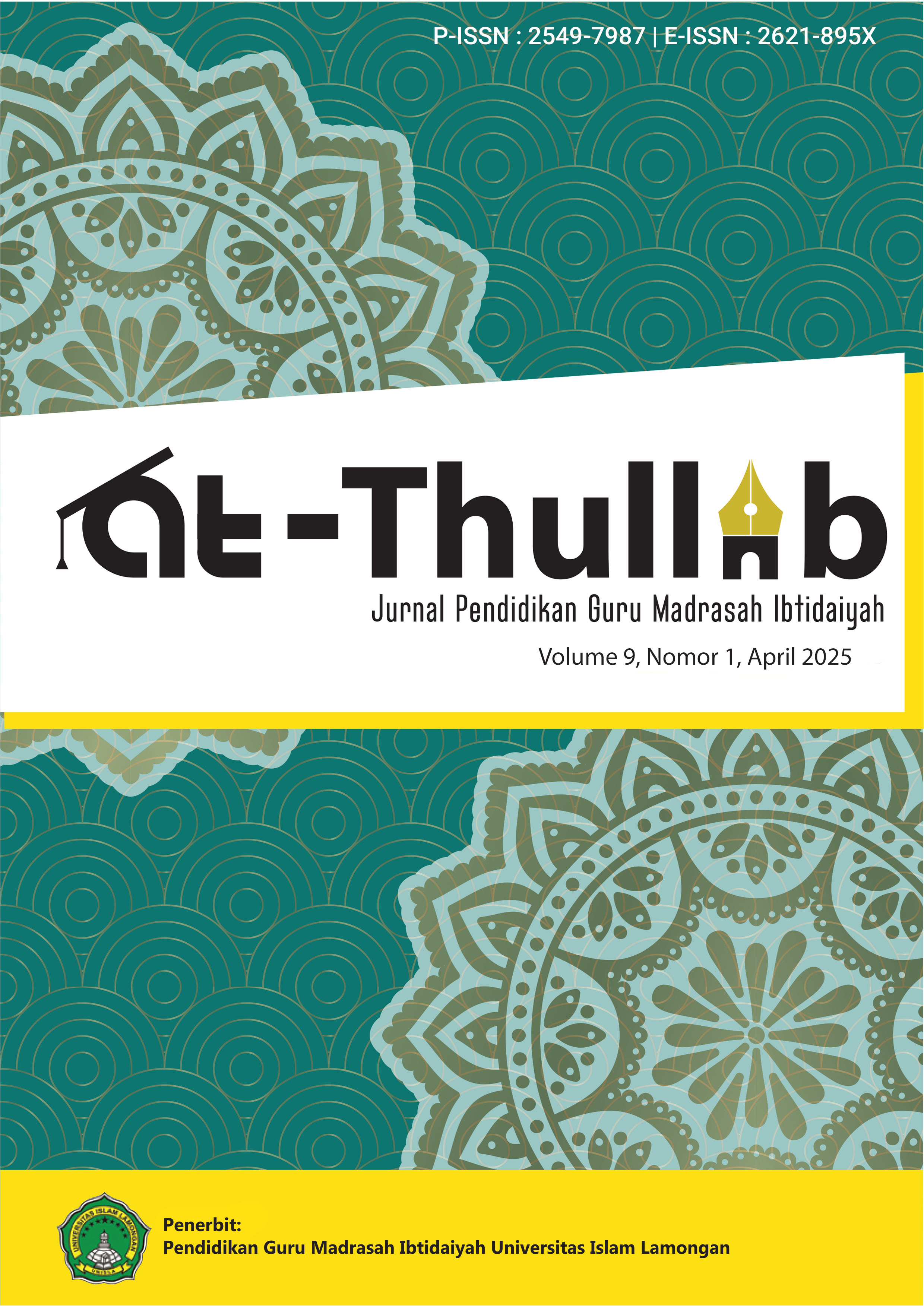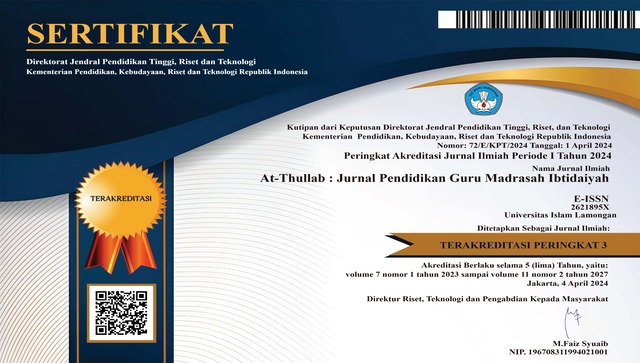Effectiveness of Problem Based Learning Model Based on Comic in Increase the Ability to Think Creativity in Elementary School Students
DOI:
https://doi.org/10.30736/atl.v9i1.2374Keywords:
PBL Model, Comics, Creative ThinkingAbstract
Study This is based on the ability reason creative low students to understand the Topic of chain food. Research objectives: Is there any use in knowing the effectiveness of the PBL-based model comic in raising the ability to think creative in Elementary School Students? Research uses a quantitative approach through a quasi-experimental design type nonequivalent pretest-posttest control class design and technique taking sample in a technique of purposive sampling. The research sample consists of the origin student class VA consists of 29 children, as well as the student class VB consists of 31 children. Data collection using instrument test ability think creative. Based on what, an independent sample t-test was conducted, it was obtained mark significance of 0.000 was obtained, which shows that there is an increased ability to think creative, which is substantial in the group experiment if compared to with group control. Implications results study. This shows that the PBL model is based on comics, not only effective in increasing creative students' ability to think, but can also become an alternative innovative approach in science learning at the Basic level. Using comics as a learning medium makes it easier to understand complex concepts like chain food while simultaneously creating a fun and interactive learning atmosphere. Conclusion study This is a PBL model based on comics, effective in raising the ability reason creative students who include fluency, flexibility, originality, and detailed explanation in Elementary School.
Downloads
References
Angga, P. M. W., Sudarma, I. K., & Suartama, I. K. (2020). E-Komik pendidikan untuk membentuk karakter dan meningkatkan hasil belajar siswa kelas V pada mata pelajaran Bahasa Indonesia. Jurnal Edutech Undiksha, 8(2), 93–106.
Aryanitha, N. P. A., & Agung, A. A. G. (2022). Lembar Kerja Peserta Didik Interaktif Berbasis Mind Mapping pada Materi Otot Manusia. Jurnal Ilmiah Pendidikan Profesi Guru, 5(1), 161–172.
Aryanto, H., Azizah, M. D., Nuraini, V. A., & Sagita, L. (2021). Inovasi tujuan pendidikan di Indonesia. JIRA: Jurnal Inovasi Dan Riset Akademik, 2(10), 1430–1440.
Damanik, D. R., & Devianty, R. (2024). Development of Children’s Comics to Improve Elementary School Students’ Reading Comprehension Ability. At-Thullab: Jurnal Pendidikan Guru Madrasah Ibtidaiyah, 8(1), 95–108.
Eka, I., Irawan, E., Ekapti, R. F., & Faizah, U. N. (2021). Efektivitas Penerapan Model Pembelajaran Problem Based Learning terhadap Peningkatan Keterampilan Berpikir Analitis. Jurnal Tadris IPA Indonesia, 1(2), 108–117. https://doi.org/10.21154/jtii.v1i2.142
Erlina, M., Oktaviana, M., Indrawati, E., Dini, R. R., & Nurhadianti, D. (2024). Collective Creative Efficacy as A Mediation of The Influence of Creative Self Efficacy on Students ’ Creativity. 9(1), 10–16.
Fahrezi, I., Taufiq, M., Akhwani, A., & Nafia’ah, N. (2020). Meta-Analisis Pengaruh Model Pembelajaran Project Based Learning Terhadap Hasil Belajar Siswa Pada Mata Pelajaran IPA Sekolah Dasar. Jurnal Ilmiah Pendidikan Profesi Guru, 3(3), 408. https://doi.org/10.23887/jippg.v3i3.28081
Fajri, L., Herianto, E., & Sawaludin, S. (2022). Pengaruh Penerapan Model Pembelajaran Problem Based Learning Berbasis Media Komik terhadap Hasil Belajar Siswa dalam Mata Pelajaran PPKn Kelas VIII di SMP Negeri 2 Lingsar.Manazhim,4(2),371–382. https://doi.org/10.36088/manazhim.v4i2.1875
Faros, A. A. (2021). pengaruh model problem based learning berbantu komik digital terhadap literasi sains peserta didik pada materi pencemaran lingkungan kelas vii di smp negeri 12 bandar lampung.
Fitriani, D., Eq, N. A., & Suhartini, A. (2021). Teologi Pendidikan: Konsep Pendidikan dalam Prespektif Islam. MANAZHIM, 3(2), 201–213.
Hagi, N. A., & Mawardi, M. (2021). Model Problem Based Learning untuk meningkatkan keterampilan berpikir kreatif siswa Sekolah Dasar. Edukatif: jurnal ilmu pendidikan, 3(2), 463–471.
Kartika, E. (2023). media pembelajaran komik digital dalam meningkatkan kemampuan memahami materi ilmu pengetahuan alam pada siswa sekolah dasar. Pendas: Jurnal Ilmiah Pendidikan Dasar, 8(2), 2858–2868.
Khumairoh, N. R. (2022). penerapan model problem based learning (pbl) berbantuan media komik digital untuk meningkatkan kemampuan berfikir kreatif peserta didik pada pembelajaran matematika (Penelitian Tindakan Kelas Pada Pokok Bahasan Volume Bangun Datar di Kelas V SDN Jatiwarin. Universitas Pendidikan Indonesia.
Maryati, I. (2018). Penerapan model pembelajaran berbasis masalah pada materi pola bilangan di kelas vii sekolah menengah pertama. Mosharafa: Jurnal Pendidikan Matematika, 7(1), 63–74.
Mayasari, A., Arifudin, O., & Juliawati, E. (2022). Implementasi Model Problem Based Learning (PBL) Dalam Meningkatkan Keaktifan Pembelajaran. Jurnal Tahsinia, 3(2), 167–175.
Ningrum, I. P., & Marsinun, R. (2022). Penerapan model pembelajaran problem based learning untuk meningkatkan kemampuan berpikir kreatif siswa. Jurnal Basicedu, 6(5), 8205–8214.
Puspitasari, I. A., Azainil, A., & Basir, A. (2022). Penggunaan media pembelajaran dalam model pembelajaran problem based learning pada mata pelajaran matematika. Prosiding Seminar Nasional Pendidikan Matematika, Universitas Mulawarman, 2, 75–92.
Rafiah, S., & Afriansyah, H. (2019). Peranan Guru Dalam Penggunaan Model Pembelajaran Problem Based Learning.
Ridwan, Y. H., Zuhdi, M., Kosim, K., & Sahidu, H. (2021). Pengembangan Media Pembelajaran Interaktif Berbasis Model Problem Based Learning Untuk Meningkatkan Kemampuan Berpikir Kreatif Fisika Peserta Didik. ORBITA: Jurnal Kajian, Inovasi Dan Aplikasi Pendidikan Fisika, 7(1), 103–108.
Simangunsong, A. R. (2021). Analisis Kemampuan Berpikir Kreatif Matematis. Jurnal Islamika Granada, 1(2), 1–7. https://doi.org/10.51849/ig.v2i1.19
Siregar, N. A., Harahap, N. R., & Harahap, H. S. (2023). Hubungan Antara Pretest dan Postest dengan Hasil Belajar Siswa Kelas Vii B Di MTS Alwashliyah Pantai Cermin. Edunomika, 07(01).
Siswoyo, A. A., Sari, E. N., Ulfa, M., & Fightiyah, R. (2022). Penerapan Model Problem Based Learning Untuk Meningkatkan Hasil Belajar Siswa Kelas V Materi Rantai Makanan SDN Socah 3. TEACHER: Jurnal Inovasi Karya Ilmiah Guru, 2(2), 200–208.
Sugiyono, S. (2010). Metode penelitian kuantitatif dan kualitatif dan R&D. Alfabeta Bandung, 170–182.
Trianziani, S. (2020). efektivitas metode problem based learning dalam meningkatkan keaktifan siswa mi tarbiyatul athfal babat. At-Thullab: Jurnal Pendidikan Guru Madrasah Ibtidaiyah, 4(November), 274–282.
Wardani, I. S., & Sulistyawati, I. (2023). Membangun Pemahaman Konsep Siswa Melalui Model Problem Based Learning. Jurnal Inovasi dan Teknologi Pendidikan, 1(3), 296–300. https://doi.org/10.46306/jurinotep.v1i3.32
Widiarti, N. K., Sudarma, I. K., & Tegeh, I. M. (2021). Meningkatkan Hasil Belajar Matematika Kelas V SD Melalui Media Video Pembelajaran. Jurnal Edutech Undiksha, 9(2), 195–205.
Downloads
Published
How to Cite
Issue
Section
License
Copyright (c) 2025 Qurrotal A'yun, Imas Srinana Wardani

This work is licensed under a Creative Commons Attribution-ShareAlike 4.0 International License.
Authors who publish with this journal agree to the following terms:
The journal allow the authors to hold the copyright without restrictions and allow the authors to retain publishing rights without restrictions. Authors retain copyright and grant the journal right of first publication with the work simultaneously licensed under a Creative Commons Attribution-ShareAlike 4.0 International License. that allows others to share the work with an acknowledgement of the work's authorship and initial publication in this journal.
Authors are able to enter into separate, additional contractual arrangements for the non-exclusive distribution of the journal's published version of the work (e.g., post it to an institutional repository or publish it in a book), with an acknowledgement of its initial publication in this journal.
Authors are permitted and encouraged to post their work online (e.g., in institutional repositories or on their website) prior to and during the submission process, as it can lead to productive exchanges, as well as earlier and greater citation of published work (See The Effect of Open Access).
The journal allows third parties (readers, researchers, and others) to share and adapt the material in line with the license. In addition, the material must be given appropriate credit, provided with a link to the license, and indicate if changes were made. If authors remix, transform, or build upon the material, they must distribute their contributions under the same license as the original.













